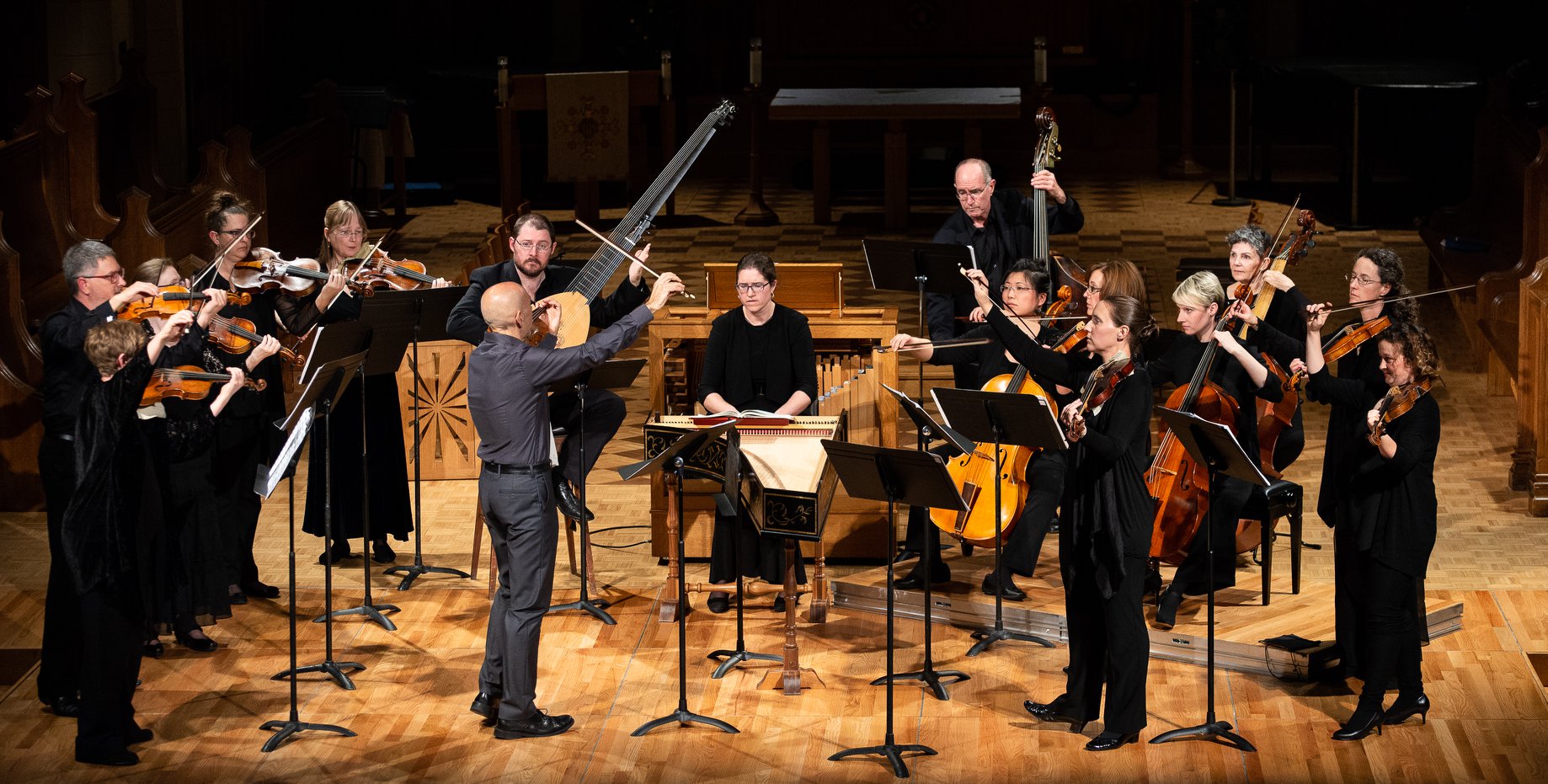ENRICO ONOFRI AND PACIFIC BAROQUE BRING WONDERFUL STRENGTH AND FEELING TO VIVALDI
Enrico Onofri (violin/ director), Pacific Baroque Orchestra (Chloe Meyers, leader): Concertos by Vivaldi, Christ Church Cathedral, September 29, 2018.
All photos by Jan Gates
One often discounts all-Vivaldi programmes as lighter fare, but this season opener of Early Music Vancouver hardly fits in this category. Under the guidance of esteemed baroque violinist Enrico Onofri, leader and soloist of the Giardino Armonico from 1987-2010, one was taken into the range of Vivaldi’s expression in a way that was almost unique in its precision, energy and feeling. In a programme of 7 concertos – 5 from L’Estro Armonico Op. 3 and 2 from La Stravaganza Op. 4 – the Pacific Baroque Orchestra performed with complete commitment and one came away from the concert feeling that Onofri and the ensemble had re-lived and re-thought this celebrated music anew.
It has been a sizeable journey from the classic Italian ‘modern instrument’ versions of Vivaldi (Virtuosi di Roma, I Musici) to the ‘authentic’ treatments of Fabio Biondi and Europe Galante, Giardino Armonico and, later still, Rinaldo Allesandrini and Concerto Italiano. The early approaches had considerable rhythmic energy and feeling but, in retrospect, they were too slow and heavy, often coated with an unnecessary romantic veneer. Biondi, in particular, showed how vividly contrasted this music could be: sparser and more intimate on one hand while having greater dramatic range on the other. Giordino Armonico in turn wedded striking precision of ensemble to a flaming passion.
Onofri’s current performances might share some of the intensity of Giordano Armonico, but the violinist’s combination of strength and subtle expressivity – both in his own playing and in the layering of the orchestral texture – produced something individual and special. It was less consciously virtuoso, and perhaps more contemplative and human. A clear virtue of his approach is that one seldom notices Vivaldi’s routine, the linearity of his musical pacing, or the omnipresence of his rhythms; each concerto is distinguished by its own special colour, vertical coherence and dramatic narrative. The starkness of the bold unison statements preceding allegros, and at the beginning of the many of the slow movements, is also distinctive and adds a dramatic, recitative-like, quality to the proceedings – each chording decisively in stone, with telling musical space in between. But energy comes quickly in the allegros, cultivating a continuing sense of build-up and release. Ascending lines typically blossom with joy but, as their projection is intensified gradually, one also feels a sense of struggle being overcome at each step. In the slow movements, the stark opening statements make way for ‘song’, leading to refined and beautiful expression for the violin soloist(s).
Onofri is a master of historical violin practice and the variety in both his ornaments and dynamics is stunning. Yet his artistry is so elegant and unassuming; he is a man of both steel and deep sensitivity, and one marvels at his reserve and discipline in displaying his virtuosity. It is fascinating to watch him play his highest notes with the truncated fingerboard of his Baroque instrument.
The opening concerto of L’Estro Armonico (Op. 3 No.1 for 4 violins) illustrated these attributes perfectly. The opening allegro was tight, exact, and full of energy but was still overflowing with joy. It featured splendid give-and-take between the soloists, and the music moved with great anticipation. After the severe opening statements of the Grave, feeling flowed forth again from the soloists, only this time with lovely patience and refinement. Both postures figured in a finale of great accuracy, colour and dramatic shape.
One could hardly help but notice the attentiveness and precision of the Pacific Baroque Orchestra. Onofri had seemingly infused the ensemble with a true love of Vivaldi, and this showed in the intense emotional commitment of the playing. Leader Chloe Meyers was particularly absorbed in the spirit of the occasion, and consistently pushed herself to her finest, but the other violin soloists were not far behind, and the bottom strings (led by cellist Beiliang Zhu) contributed lovely thrust and sinew throughout.
The two concertos from La Stravaganza Op. 4 (a set of 12 pieces, all for one solo violin) were as inspiring. In both the allegros of No. 4 and No. 1, Onofri’s success in finding lyrical reach within an otherwise tight structure was illuminating, while the succeeding movements displayed a natural inevitability in their motion. The violinist’s solo excursions were both structurally-aware and precise. In slow movements, he would work slowly to such refined, penetrating expression that he could not help but draw us into his own private world. There wasn’t a trace of sentimentality here – only perfectly distilled beauty. The cunning balance and accuracy in the quicker movements was engrossing too – and what incredible speed there was in Onofri’s fingering at the end of No. 4.
Returning to L’Estro Armonico, the inspired No. 10 (for four violins) was given a strong dramatic profile. No. 8 had delicious point and variety in its opening foray, with beautiful suspension in the Larghetto; Onofri and Chloe Meyers played together in manner born. Nos. 9 and 11 were illuminating much beyond exposing their links to Handel; indeed, the latter closed the concert as a real tour-de-force. From the light violin brushes of the opening, through the fugal development, to the spiccati and wondrous gossamer-like weaving of the two violins in the Largo (probably the highlight of the night), this closing piece emerged as overwhelming in its communication and variety. Onofri and Meyers again worked together as one expressive instrument.
This was a fully inspiring and memorable evening of music making. There can be little doubt that patrons left the hall thinking that Vivaldi was a much greater composer than they had previously surmised. I know I did.
© Geoffrey Newman 2018


